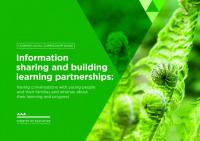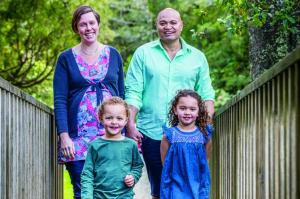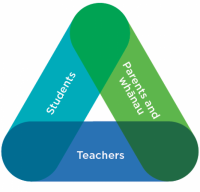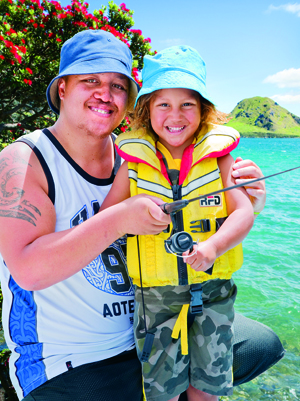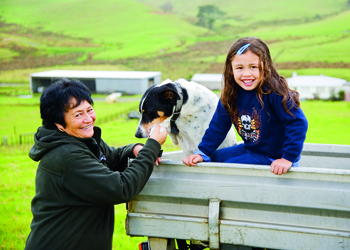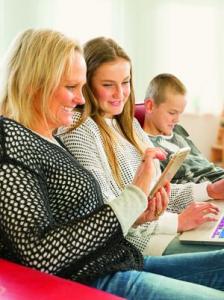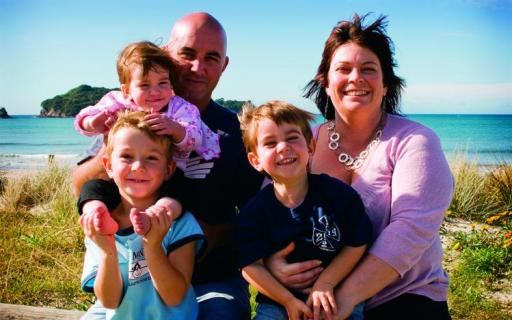Relationships for learning
What actions underpin your relationships for learning?
What information do parents and whānau want to share? | Teachers?
Essential teaching and learning conversations – when and how? | What can you do now?
You can use it to lead conversations with:
- your staff, parents, whānau, hapū, iwi, and the wider community – so you can better understand what opportunities there are to build and strengthen learning partnerships
- your staff – to review your local information sharing practices and decide what is working well and what can be improved.
It contains guidance, review questions, activities, examples, and resources to enable deep discussions in your school about information sharing and learning partnerships. These discussions will help to maintain a clear focus on equitable and positive outcomes for all your students. The start of the year is a good time to begin conversations with your staff that can continue throughout the year.
Where can you get further support?
The guide series is part of a package, including workshops and tools that will support schools to develop and review local curriculum.
Email [email protected] or contact your local Ministry of Education office for further support and information.
Poipoia te kākano kia puāwai
Nurture the seed and it will blossom
Relationships for learning
Child wellbeing at the heart
Information sharing and building partnerships is about developing three-way genuine relationships that focus on learning and progress. They’re the sorts of relationships in which you know that you are working together on something that is really important – a child’s learning and wellbeing.
Why are three-way partnerships important?
- Students want to learn and progress – to do so they need to want to take risks, make changes, and share their thinking with others.
- Teachers make a difference – they are the best in-school influence on learning. Teachers know and understand pedagogy and curriculum.
- Parents and whānau know their child best.
"I love being in control of what I am doing, it means I get to do what I love and makes me feel more capable, strong and trusted. Being told what to do is not learning, it is just being told what to do."
11 Year old girl, Year 7
"Good teachers, teachers who are helpful, they make the difference between me achieving and failing."
Student in alternative education – Māori; Office of the Children's Commissioner – Education Matters to Me: Experiences of Tamariki and Rangatahi Māori report
Ākonga are more likely to make progress and succeed when parents and whānau, and their teachers:
- work together in a way that is focused on learning
- share information and acknowledge expertise
- understand and celebrate similarities and differences.
School conditions should support parents, whānau, and students to be active partners in learning.
"You know your child better than anyone, including their strengths and weaknesses, their interests and talents, and what works for them.
You are the most important out-of-school influence on your child’s educational success."
Education Review Office Partners in Learning (Guide to Parents)
"I would like to be part of the team who creates plans for my child. I would like to understand the system and support my child."
Parent/whānau - European
"I want an inclusive environment which respects diversity of the learners at school. I want teachers to recognise prior learning and respect cultural capital of each learner."
Parent/whānau - New Zealand European/Pākehā, Filipino
Examples of schools developing the conditions for students, parents and whānau to participate
Return to top
What actions underpin your relationships for learning?
Schools are moving away from the notion of a one-way flow of information to two-way, ongoing, genuine information sharing between teachers, parents and whānau.
Conversations about student progress and achievement across the curriculum require meaningful, ongoing information sharing processes. It’s important that roles and expectations are clear for students, teachers, parents, whānau, and the wider community. Sharing information is an essential part of creating relationships for learning.
When it comes to sharing information for learning, there is broad agreement about what we don’t want. We don’t want accountability-driven, one-way flow of information processes such as those shown in the table below.
| One-way, accountability-focused reporting
| Information sharing that informs learning and builds partnerships (to be filled out in the Activity)
|
| Teachers report to parents what their children have learned or achieved.
|
|
| The focus is on describing successes and failures.
|
|
| Accountability and compliance are the key drivers.
|
|
| Reporting is done once or twice a year only.
|
|
| Reporting takes no heed of parents’ knowledge and views about their children’s learning.
|
|
| Reporting is from school to parent, essentially a one-way “take it or leave it” message.
|
|
| Paper-based reports are sent home.
|
|
Indicators that your school would like “information sharing that informs learning and builds partnerships”
Refer to the table above, create indicators that are meaningful for you that you want to go under the heading – "Information sharing that informs learning and builds partnerships".
- What else would families and whānau add to the criteria? Treat it as a living draft.
- Use these indicators as a set of criteria to check the work you actually do (note that you will use this criteria for other activities in this guide). This criteria will help you to make decisions about what to stop, start, and do more.
Further resource for guidance
The Education Review Office has developed a set of indicators and examples of effective practice for educationally powerful connections and relationships.
You may find it useful to discuss the following effective practices – School Evaluation Indicators – Domain 3: Educationally powerful connections and relationships p. 26
Return to top
What information do parents and whānau want to share?
Parents and whānau expressed their views through the Education Conversation. They said they would like more:
- information about their child’s progress, including how they can support their child’s learning
- information beyond academic achievement, including student wellbeing, social and cultural learning
- opportunities to contribute to local curriculum and other decisions that impact students.
"[We] would like to be consulted with before education decisions that affect my child’s future are made and implemented."
Parent/whānau – Māori
"My son’s teacher has asked about his interests and they have been [uptaken] for use in classes."
Parent/whānau – European
"Information that addresses their holistic learning including cultural, as opposed to just academic."
Parent/whānau – Tongan
What do teachers want to share?
Through the Education Conversation, teachers expressed that they want to share what students are doing across the curriculum, including their successes. Teachers said they wanted to help when things get a bit tough. They want conversations that focus on future actions and summarise learning progress at key points in time.
"We’ve been sharing progress about literacy and maths and suggesting to parents what they could be doing at home but we have rarely said much about the whole curriculum. Even our conferencing has focused on literacy and maths yet children’s art work and other project work is all around the room. It would be good to focus on and celebrate the whole child when we talk with parents."
Teacher, Taranaki Full Primary
What does good practice in building relationships with parents and whānau look like?
Explore the stories of schools building strong relationships with parents and whānau throughout this guide.
Reviewing your information-sharing approach
Discuss what you would like to share with parents and whānau. Think about the whole curriculum, certain events you have at school, your school vision, and individual student goals. Work in small groups such as in syndicates or learning areas.
Compare and contrast what you want to share.
- Does it change as children get older?
- Is it the same for all learning areas?
- Do you think you have captured the essence of what is important for your setting? How will you ensure this approach reflects a genuine partnership between school and home?
How does your description of what all parties want to share match your criteria for information sharing and building partnerships?
What schools are doing to find out what parents want
These schools have used surveys, hui and fono to actively engage with parents and whānau, including what they want to know about their child’s learning.
Return to top
Essential teaching and learning conversations – when and how?
It’s a good idea to plan the learning conversations that you want to take place over the year. There are many opportunities for conversations about learning and progress with these three purposes:
- Setting goals and developing new relationships at the beginning of the year
- Ongoing sharing, for example, celebrating particular successes at home or school
- Summarising learning progress at key points in time to illuminate what has been learnt and inform future learning.
Some conversations are more critical than others. For example:
- setting goals and developing relationships with new families and students at the beginning of the year or when they arrive at the school
- ongoing conversations to ensure success and wellbeing for students whose wellbeing is at risk and/or learning progress needs focused support.
Helping to get the critical conversations right
Everyone wants information sharing to be timely and manageable. This can look different for different people. There needs to be careful consideration about when and how.
"Taking a multi-modal approach including paper surveys, online surveys, hui, events, focus groups."
Principal – New Zealand European/Pākehā
"Offering a variety of ways for engagement – digital, face to face, and offering multiple opportunities."
Tumaki – Māori
"Face to face meetings. Hui that involve students performing or showing their learning. Visits to homes when parents don’t come to school."
Principal – New Zealand European/Pākehā
"We are invited to hui and asked for input on our children’s education. The kura consults with us the whānau on what better works for our children."
Parent/whānau – Māori
Mapping when and how you share information with students, parents, and whānau
In small groups, discuss your context and then fill in the left-hand cell of this table.
| What is shared/discussed?
| When?
| How?
|
|
|
|
|
Now take what you share and use the questions below to help you fill in the other two cells of the table.
- What conversations happen at the classroom level? (for example, during goal setting, capability building, regular informal communication, student conferencing, development of portfolios (digital and hard copy), three-way conferencing)
- What conversations happen at the school level? (for example, consultation on annual goals and actions, discussions with particular groups, reporting on progress)
- Identify the “flow” and connections between classroom-level and school-level conversations. Are they clear to all teachers? Would students and their parents and whānau understand them?
- Identify any gaps or bottlenecks in communication.
- How does your mapping match your criteria for information sharing and building learning partnerships?
Reviewing community expectations
- How do you know what forms of communication different parents expect from the school? Is it timely to ask again?
- Do you find it difficult to communicate with particular families? Have we asked them what works best for them?
- Who in your community can help you make connections with whānau? (for example, fluent language speakers)
Example of a school explaining expectations around a student-led conference
Point Chevalier School – Student led conferences
Point Chevalier School describes the purpose of three-way conversations, why they are important, and how parents can help their child before, during, and after conferences.
Return to top
What can you do now?
Get more inspiration and explore what other schools have done
This report has examples of schools implementing deliberate strategies to improve their learning partnerships. Each case explores the review the school undertook and the changes they are making. ERO also has some starter questions that may be useful for your discussions.
Building genuine learning partnerships with parents, ERO 2018.
Some examples from the report:
- Belmont School is moving to genuine relational and learning partnerships with parents, families and whānau. The school has been identifying the extent of their partnerships, changing to genuine partnerships, and looking at ways to sustain the improvements.
- Oratia School is using and responding to a leader-led inquiry to improve learner-centred relationships with parents. They have developed a number of partnership strategies.
- Papatoetoe North School is developing genuine learning partnerships with parents to help both children and teachers. They have been seeking and using parents’ views and knowledge, sharing information and resources with parents while at the same time reinforcing the benefits of the parents’ role.
- Christ the King School is improving educationally powerful connections with parents, and in particular, with parents of Māori children involved in targeted support.
- Aberdeen School and East Taieri School have had a similar focus to Christ the King School.
- Sylvia Park School is exploring how comprehensive information enables parents to support their child’s learning at home. They have been collecting and sharing comprehensive assessment information about children’s goals and next learning steps, and involving parents in their children’s learning.
- Woodend School, Gleniti School, and Milson School are working with parents on transitions to and within a school.
What could you do differently when goal setting with students, their parents and whānau?
Review your criteria for information sharing and building partnerships.
How can you use this opportunity to:
- create the conditions so parents, whānau, and students can be active partners in learning
- find out what parents and whānau want to share, when and how
- focus on building partnerships for learning
- support parents, whānau, and students to understand how learning conversations connect over the year?
Create a timeline for information-sharing
When you have agreement on what should be shared when, and how.
- The next step is to develop a visual timeline graphic for students and their families and whānau about information sharing about goals and progress (there might be different graphics for different year groups).
- Share this visual graphic to parents and whānau so it becomes part of the fabric of your school – for example, you may want to put it on your website, and bring it in hard copy when talking with parents face to face.
Innovate – trial some new ideas
There may be some teachers, with parents and whānau, who are willing to trial some new ideas. For example, you might want to trial: a new way of digitally sharing, new topics on a written report, having students contribute to the written report. Make sure the ideas to be trialled have:
- clear criteria and a process for evaluating the impact; and
- that the trial and its outcome is shared amongst other teachers and the Board of Trustees.
Not all trials are successful; however if the trial shows promise, ensure you can resource any changes to practice school-wide.
Published on: 27 Nov 2019
Return to top

